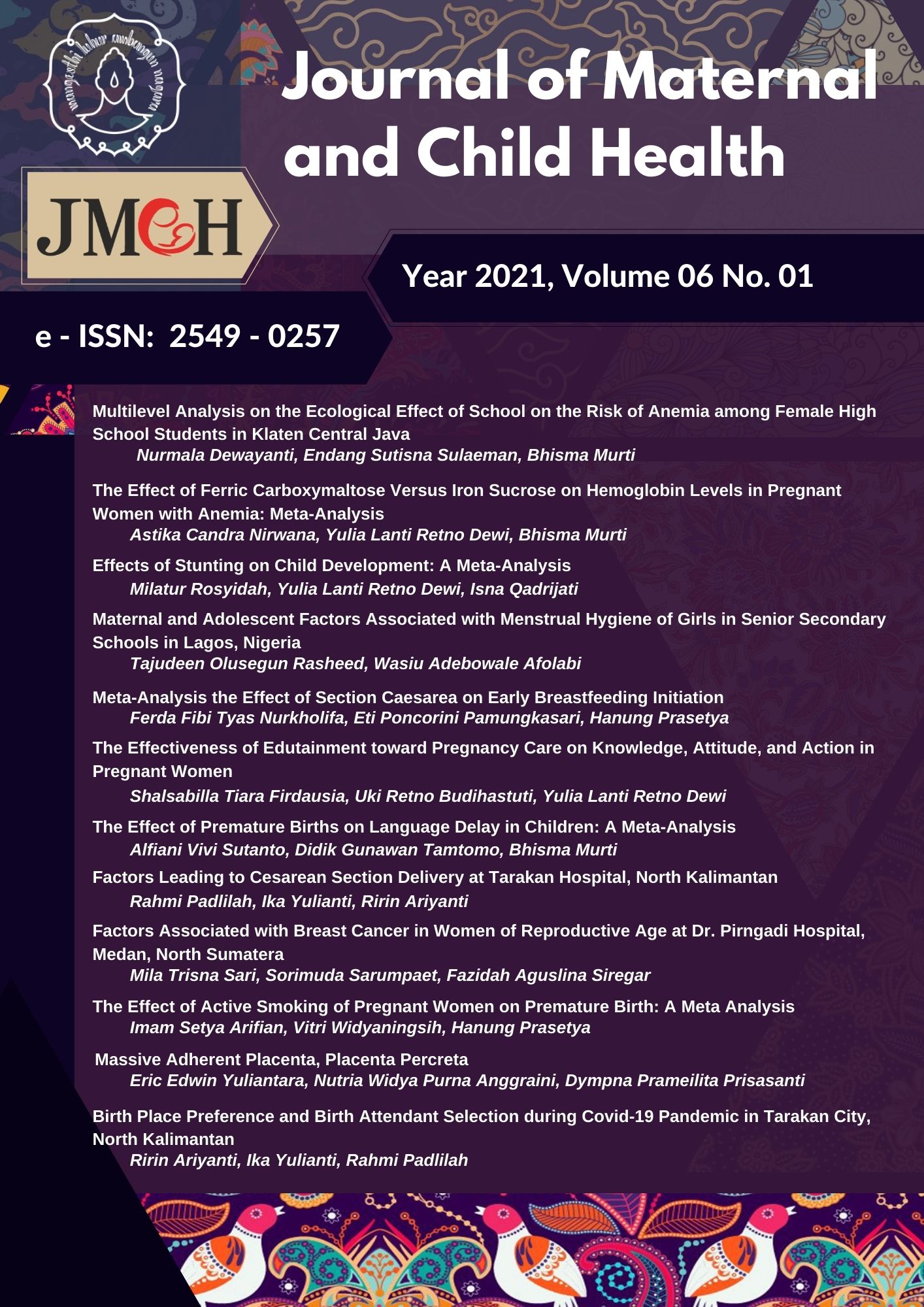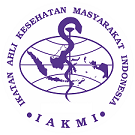Maternal and Adolescent Factors Associated with Menstrual Hygiene of Girls in Senior Secondary Schools in Lagos, Nigeria
Abstract
Background:
References
Anchebi HT, Shiferaw BZ, Fite RO, Abeya SG (2017). Practice of menstrual hygiene and associated factors among female high school students in Adama Town. Ethiopia. J Women's Health Care 6: 370. doi:10.4172/2167-0420.1000370.
Anusree PC, Roy A, Sara AB, Faseela VCM, Babu GP, Tamrakar A (2014). Know-ledge regarding menstrual hygiene among adolescent girls in selected school, Mangalore with a view to develop an information booklet. J Nur Health Sci. 3: 55-60. https://www.-researchgate.net/deref/http%3A%2F%2Fdx.doi.org%2F10.9790%2F1959-03145560.
Bacha K, Tadesse G, Kasim W (2016). Assessment of knowledge and practice of adolescent girls in-School towards menstrual hygiene manage-ment and determining factors in Lucy village of Ethiopian Great Rift Valley. Int J Immunol. 4(6): 52-63. doi: 10.11648/j.iji.20160406.12.
Bandi ND, Arumugam CP, Venkata M, Nannam L (2016). Utility of the PALM-COEIN classification of abnor-mal uterine bleeding for Indian gyne-cologists. Int J Gynaecol Obstet. 133: (2): 196-198. https://doi.org/10.1016-/j.ijgo.2015.09.030.
Belayhun B (2015). Knowledge, Attitude and Practices (KAP) Survey, Analysis and Communication Strategy Report on (Eight Towns and 27 Satellite Villages). UNICEF. 20
Boosey R, Prestwich G, Deave T (2014). Menstrual hygiene management amongst schoolgirls in the Rukungiri district of Uganda and the impact on their education: a cross-sectional study. Pan Afr Med J. 19: 253. doi:10.11604/pamj.2014.19.253.5313
Dhanage C, Wadde S, Bhise M, Mantri S (2015). A study of assessment of knowledge and behaviours regarding menstruation among School going adolescent girls who had attained menarche. Int J Soc Prev Med. 1(1): 13-8. DOI: 10.18203/2394-6040.ijc-mph20194005.
Das P, Baker KK, Dutta A, Swain T, Sahoo S, Das BS (2015). Menstrual hygiene practices, WASH access and the risk of urogenital infection in women from Odisha. India PLoS One. 10(6): 1
Ekpenyong C, Davis K, Akpan U, Daniel N (2014). Academic stress and mens-trual disorders among female under-graduates in Uyo, South Eastern Nigeria
Field A (2013).Discovering statistics using IBM SPSS statistics. (4th Ed.). London: Sage.
George R (2014). What Is Life like When Your Period Means You Are Shunned by Society?. New statesman. https://-www.newstatesman.com/world-affa-irs/2014/03/what-life-when-your-pe-riod-means-you-are-shunned-society.
Gultie T (2014). Practice of menstrual hygiene and associated factors among female Mehalmeda high school students in Amhara regional state, Ethiopia. Sci J Public Health. 2(3): 189-195. doi: 10.11648/j.sjph.201402-03.18.
Hall JE (2010). Guyton and Hall Textbook of medical physiology. 12th ed. Phila-dephia: health education on adoles-cent girls in rural schools and colleges.
House S, Mahon T, Cavill S (2012). Mens-trual Hygiene Matters: A Resource for Improving Menstrual Hygiene around the World. Retrieved from www.-wateraid.org/mhm
Kariappa T, Sathish T, Saha A (2016). His-topathological study of endometrium indysfunctional uterine bleeding. The Pharma Innovation Journal. 5: (1), 29-32. https://www.thepharmajour-nal.com/archives/2016/vol5issue1/PartA/4-10-4.pdf.
Karout N (2015). Knowledge and beliefs regarding menstruation among Saudi nursing Students. J Nurs Educ Pract. 6(1): 23-30. https://doi.org/10.5430-/jnep.v6n1p23.
Knol HM, Mulder A B, Bogchelman D H, Kluin- Nelemans H C. van der Zee A GJ, Meijer K (2013). The prevalence of underlying bleeding disorders in patients with heavy menstrual bleed-ing with and without gynecologic abnormalities. Am J Obstet Gynecol. 209(3): 202.e1-202.e7. https://doi.-org/10.1016/j.ajog.2013.05.059.
Lawan UM, Wali NF, Musa AB (2010). Menstruation and menstrual hygiene amongst adolescent school girls in Kano, Northwestern Nigeria. Afr J Reprod Health. 14(3): 201-7. PMID: 21495614.
Marvan ML, Molina-AboInik M (2012). Mexican adolescents
Oche MO, Umar AS, Gana GJ, Ango JT (2012). Menstrual health: the unmet needs of adolescent girls
Ogunsola OA, Ogundele, OA, Phillips O, Ogunsola T (2014). Knowledge, practices and socio-cultural restrictions associated with menstruation and menstrual hygiene among in-school adolescents in Ile-Ife, Nigeria. Int J Prev Med. 16(1). https://ispub.com/-doi/10.5580/IJPRM.22309.
Pender NJ (1996). Health Promotion Model. http://www.nursing-theory-.org/theories-and-models/pender-health-promotion-model.php
Polit DF, Beck CT (2013). Essentials of Nursing Research: Appraising Evi-dence for Nursing Practice Eighth, North American Edition
Pokhrel S, Mahantashetti N, Angolkar M, Devkota N (2014). Impact of health education on knowledge, attitude and practice regarding menstrual hygiene among pre university female students of a college located in urban area of Belgaum. IOSR Journal of Nursing and Health Science. 3(4): 38-44. https://www.iosrjournals.org/iosr-jn-hs/papers/vol3-issue4/Version-1/I0-3413844.pdf.
Sikiru L, Charles IE, Uche AE, Augustine AA, Maduabuchukwu JN, Amaeze FN (2013). Exercise and menstrual func-tion: A review study. BMJ. 334(7586): 164
Sooki Z, Shariati M, Chaman R, Khosravi A, Effatpanah M, Keramat A (2016). The role of mother in informing girls about puberty: A meta-analysis study. Nurs Midwifery Stud. 5(1): e30360. https://doi.org/10.17795/nmsjournal30360.
Sommer M, Caruso BA, Sahin M, Calderon T, Cavill S, Mahon T (2016). A time for global action: addressing girls
Su JJ, Lindell D, Sudeshna R, Aparajita D (2012). Promoting the menstrual health of adolescent girls in China. Nurs Health Sci. 18(4): 481-487. https://doi.org/10.1111/nhs.12295.
Tharkre S, Reddy M, Rathi N, Pathak K, Ughade S (2011). Menstrual hygiene: knowledge and practice among adolescent school girls of Saoner, Nagpur District. J Clinic Diagnos Res. 5: 1027-33.
UNICEF, University E (2013). WASH in Schools Empowers Girls' Education-tools for assessing menstrual hygiene management in schools.
UNICEF (2011). State of Worlds Children-Adolescence: An age of opportunity. http://www.unicef.org/sowc2011/pdfs/.
Valizade R, Taymoori P, Yousefi FY, Rahimi L, Ghaderi N (2016). The Effect of Puberty Health Education based on Health Belief Model on Health Behaviors and Preventive among Teen Boys in Marivan, North West of Iran. Int J Pediatrics. 4(8): 3271-81.
Patil VV, Udgiri R (2016). Menstrual hygi-enic practices among adolescent girls of rural North Karnataka region, India. International J Community Med Public Health. 3(7): 1872-1876. https://dx.doi.org/10.18203/2394-6-040.ijcmph20162058.
WHO, UNICEF (2017). Progress on drink-ing water, sanitation and hygiene: 2017 update and SDG baselines. Geneva.
WHO (1966).
Yamane T (1973). Statistics and Introduc-tion Analysis. 3 Edition. New York. Retrieved from: http://www.sciepub-.com/reference/116479.




